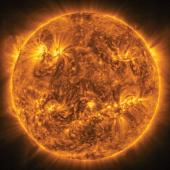May Showers
Spring's shooting stars.
I see thy glory like a shooting star
Fall to the base earth from the firmament.
—Shakespeare, Richard II
Ah, spring in Montana! Maybe the nights are balmier. Maybe the buds are popping. Maybe it’s stopped snowing. Regardless, some things are reliable, and we find some of those things in the sky.
As the Earth trundles in its orbit around the sun, it annually passes near or through the debris trails of comets, those “dirty snowballs” of ice and dust that shed like mangy dogs when they swing around the sun and are warmed by it. Ices vaporize and blow away, but liberated bits of dust and dirt are left in the comets’ wakes, all around their orbits. When Earth encounters these comet trails, the mostly sand-sized bits of debris slam into the atmosphere, briefly flare into incandescence as they burn up, and become meteors—the colloquial “shooting stars.”
You can see stray meteors any night of the year, but when Earth encounters the dust trail of a comet, it’s like hitting a cloud of caddisflies in May along the Madison River. Along the Madison, you get a windshield covered in bug parts. In the sky, you get a meteor shower.
May’s annual version of a celestial bugfest is called the Eta Aquarid meteor shower. In early May, Earth’s path takes it through a stream of solid particles left behind by the famous Halley’s Comet. They come at us from the direction of the star Eta Aquarii in the constellation of Aquarius the water bearer (which rises before dawn), hence the name. The meteors seem to radiate across the sky from a point appropriately called the “radiant.” (We pass through the same debris stream from Halley’s Comet again in October, when the meteors radiate from the constellation Orion and are called the Orionid meteor shower.)
The radiant is quite southerly for Montanans, and thus the Eta Aquarids are a more prolific shower for those living nearer the Equator, who find the radiant rising earlier in the night and getting higher in their sky. But we can still see 10-20 shooting stars per hour, or a few more, if conditions are good. This year, the moon is essentially in new phase, so the sky will be dark, enhancing the view.
Aquarius rises around 4:30am in the east in early May, to the right of the Great Square of Pegasus which is easier to find. So the best time to go out and look for meteors is from 4:30 until the sky begins to brighten around 6am, on the morning of May 5, the day the shower reaches its peak (although you can see some meteors on mornings around this date as well).
It’s not the showiest meteor shower of the year for us (August’s Perseids and December’s Geminids do better), but you can see some lovely meteors at a time of year when the weather is starting to get pleasanter for sky-gazing again. So get up a little before the birds with your cup of Joe, pop out, and enjoy the early-morning sky. Jupiter will be shining in the south, the stars of summer will stretch from the southern horizon to overhead, and meteors should be periodically punctuating the heavens.
Find a good view toward the east-southeast in a dark location, lie on a blanket or reclining lawn chair with your feet aimed in that direction, take in as much of the sky as you can, and wait for the celestial caddisflies to splat against the windshield of the atmosphere in the merry month of May.
Jim Manning is the former executive director of the Astronomical Society of the Pacific. He lives in Bozeman.












